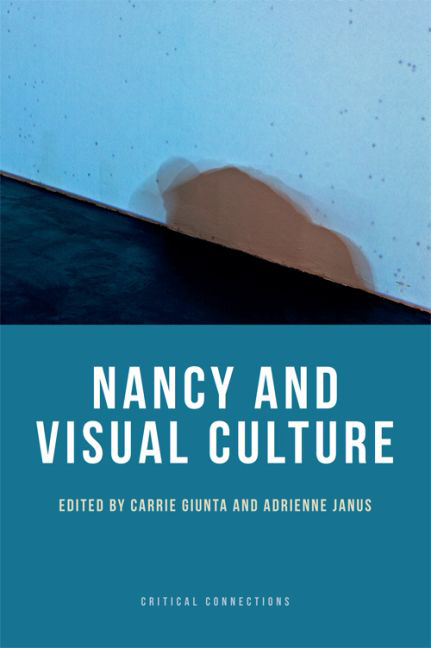Book contents
- Frontmatter
- Contents
- List of illustrations
- Acknowledgements
- Introduction: Jean-Luc Nancy and the Image of Visual Culture
- 1 Cutting and Letting-Be
- 2 Dancing Equality: Image, Imitation and Participation
- 3 A Question of Listening: Nancean Resonance, Return and Relation in Charlie Chaplin
- 4 The Image: Mimesis and Methexis
- 5 On the Threshold: Visual Culture, Invisible Nature
- 6 Pornosophy: Jean-Luc Nancy and the Pornographic Image
- 7 Presentation and Disappearance: Dialogue between Soun-Gui Kim and Jean-Luc Nancy
- 8 Writing in the Place of the Animal
- 9 Together at the Limit: Jean-Luc Nancy, Art and Community
- 10 Turning Around the Written Mark, Opening from a Weight of Thought
- 11 Uncanny Landscapes of Photography: The Partage of Double-Exposure after Jean-Luc Nancy
- Contributors
- Bibliography
- Index
5 - On the Threshold: Visual Culture, Invisible Nature
Published online by Cambridge University Press: 15 September 2017
- Frontmatter
- Contents
- List of illustrations
- Acknowledgements
- Introduction: Jean-Luc Nancy and the Image of Visual Culture
- 1 Cutting and Letting-Be
- 2 Dancing Equality: Image, Imitation and Participation
- 3 A Question of Listening: Nancean Resonance, Return and Relation in Charlie Chaplin
- 4 The Image: Mimesis and Methexis
- 5 On the Threshold: Visual Culture, Invisible Nature
- 6 Pornosophy: Jean-Luc Nancy and the Pornographic Image
- 7 Presentation and Disappearance: Dialogue between Soun-Gui Kim and Jean-Luc Nancy
- 8 Writing in the Place of the Animal
- 9 Together at the Limit: Jean-Luc Nancy, Art and Community
- 10 Turning Around the Written Mark, Opening from a Weight of Thought
- 11 Uncanny Landscapes of Photography: The Partage of Double-Exposure after Jean-Luc Nancy
- Contributors
- Bibliography
- Index
Summary
‘See the invisible, not beyond the visible, nor inside, nor outside, but right at it, on the threshold …’ Nancy makes his provocative imperative in an essay entitled ‘On the Threshold’ in relation to a painting by Carvaggio. In it, he calls attention to the invisible as the proverbial ‘blind-spot’ of visual culture, a blind-spot articulated most prominently in W. J. T. Mitchell's ‘Critique of Visual Culture’ as including the invisible, blindness, the unseen as well as other sensory modalities such as the tactile, the auditory and the haptic. This imperative also raises the question of what modality of vision could conceivably see the invisible right at the threshold of the visible, and as its logical corollary, where this threshold is located, if not ‘beyond the visible’ in the realm of a transcendent spiritual principle, idea or signified, ‘inside the visible’ in the workings of a subjective consciousness (whether of the artist or spectator), or ‘outside the visible’ in the hidden traces of a larger material culture that the art work as an object may reveal.
In this chapter, I will explore two particular aspects of Nancy's conception of the image, and the modalities of vision corollary to it, by tracing the location of the threshold between the visible and the invisible as it moves in Nancy's writing between two different conceptual registers. The first might be called the ‘macro’ register of the Nancean body conceived as discontinuous sensual zones. Here, when vision as a modality of seeing visible forms reaches the limit point of intensity in relation to the image, it begins to resonate against the limits of other sensual zones, and is described by Nancy as a modality of listening or of touch, senses attendant to the invisible or the unseen. The second conceptual register is the ‘micro’ register of particles and waves, where, in the resonance of sense and the senses set in motion in relation to the image, Nancy's descriptions of images as visible forms dissolves into descriptions of the invisible forces of physics, forces relating not only to the physics of light, but of sound and impact. Thus Nancy describes the light of the photographic image as the ‘absolute velocity of appearing bodies, the sculpture of their mass’;…
- Type
- Chapter
- Information
- Nancy and Visual Culture , pp. 93 - 108Publisher: Edinburgh University PressPrint publication year: 2016



